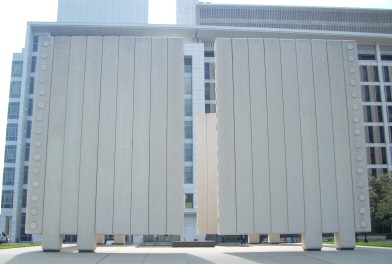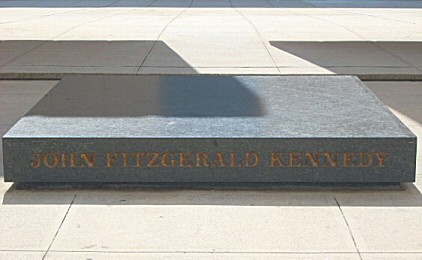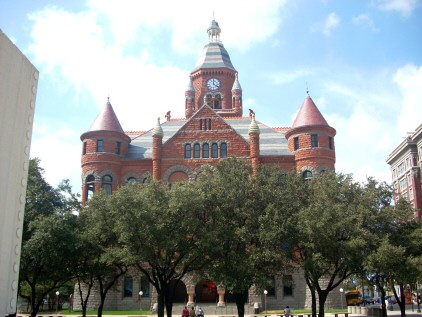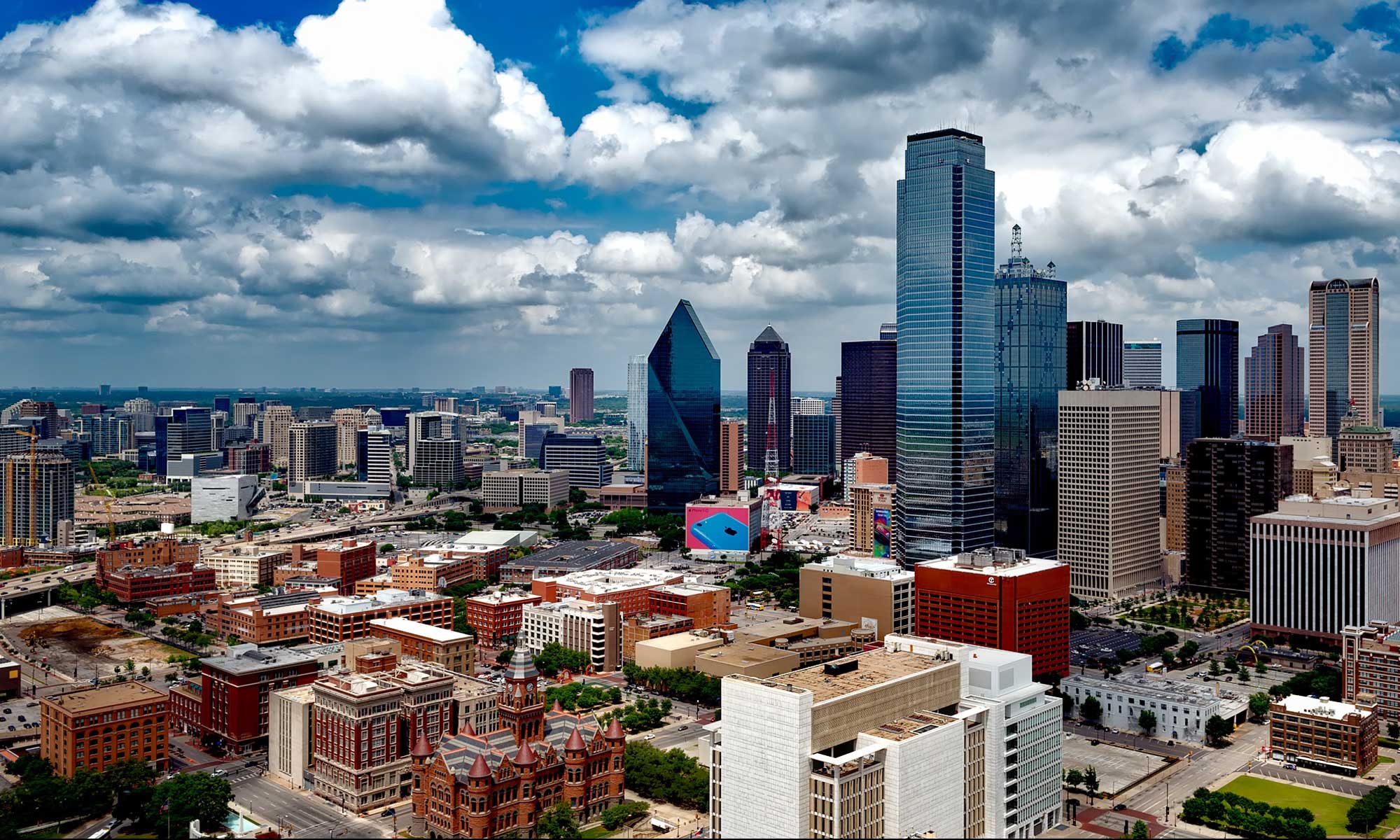A while back I wrote a brief entry about the Sixth Floor Museum — the facility in Dallas’ historic West End that celebrates the life (and tragic death) of President John F. Kennedy, who was murdered by an assassin stationed in the very warehouse, and on the very floor, where the museum is located now. The Sixth Floor Museum is the most obvious of the local tributes to that day in November 1963, but it’s not the only reminder of our shared civic tragedy.
For more than a decade, there was another museum in town that took an alternate approach to the assassination — an Oliver Stone/Jim Garrison approach. From 1995 until December 2006, the privately owned JFK Conspiracy Museum served up big, steaming helpings of conspiracy theory regarding President Kennedy’s life and death. Any theory was fair game, even if it contradicted other theories championed by the museum. There were even LBJ conspiracy theories and UFO conspiracy theories mixed up in there. It’s just as well, I suppose, that it was booted out of its location in December 2006, in favor of a Quiznos sandwich shop. The owner promised to reopen somewhere else the following spring, but as of this writing (October 3, 2007) that hasn’t yet happened.
Right across the street from the former location of the Conspiracy Museum is a more significant and less strident memorial to JFK: in fact, it’s the official one. It’s an open-air structure created by architect Philip Johnson, a friend of the Kennedy family, and approved by Jackie Kennedy. It was completed in 1970. Of course, JFK’s body was laid to rest at Arlington National Cemetery*, so this makes the Memorial a cenotaph — a tomb lacking the remains of the person it honors.
To be honest, the JFK Memorial isn’t much compared to the buildings around it, and it’s easy to miss. It’s been likened to a box made of Lego blocks, and is made — of all things — out of pre-cast, painted concrete. Check it out:

The Memorial’s best feature is the black granite slab in the center, which has JOHN FITZGERALD KENNEDY carved on one side and highlighted in gold leaf. It would have been a lot smarter to put the president’s name on the top, I think, but I suppose the architect wanted it to be seen from the open front of the monument.

Frankly, JFK deserved better, and people have been saying that for years. His Memorial only measures fifty feet square and thirty feet tall, and has almost no decorative elements at all. That might work for the Rothko Chapel or something (which is actually better-looking than the JFK Memorial, if not by much), but for a presidential monument? What were they smoking? Hell, one of the Memorial’s best features is that it’s right next to this:

That’s the Old Red Courthouse, built in 1890 and recently renovated into a museum. I can honestly say it’s my favorite building in Dallas. However, a memorial’s impact should come from its architectural features, not just from its location. That the JFK Memorial is more memorable for its proximity to Old Red than for its own details is just sad.
Be that as it may, the Memorial itself does have one feature that I like, despite the fact that it needs a good edit. This plaque is set into the plaza concrete a few dozen yards away from the monument, almost as an afterthought:

In case you can’t read what it says, here’s the text in full:
The joy and excitement of John Fitzgerald Kennedy’s life belonged to all men.
So did the pain and sorrow of his death.
When he died on November 22, 1963, shock and agony touched human conscience throughout the world. In Dallas, Texas there was a special sorrow.
The young President died in Dallas. The death bullets were fired 200 yards west of this site.
This Memorial, designed by Philip Johnson, was erected by the people of Dallas. Thousands of citizens contributed support, money and effort.
It is not a Memorial to the pain and sorrow of death, but stands as a permanent tribute to the joy and excitement of one man’s life.
John Fitzgerald Kennedy’s life.
Thousands of Dallasites might have contributed to the design and erection of the monument, but millions thereafter contributed to its neglect. While I admit that I find the Memorial less than overwhelming, I’m infuriated that it was allowed to degrade the way it did. Dallas soil tends to settle (being the blackland clay that it is), and it wasn’t long before cracks developed in the Memorial walls and the concrete started flaking off. Eventually the reinforcement bar became exposed in some places, and some of the medallions (those round Lego parts) were detached. Naturally, the Memorial was also vandalized repeatedly, and even the granite block was damaged. It was freaking embarrassing.
There’s no telling why it was allowed to get this way. Most of the intervening years since its construction had been good ones for Dallas, and most of the 1990s were great ones. So the city could doubtless afford its upkeep, despite the city government’s tendency to spend city funds on fat construction products for their friends (we just had 16 current and former city officials indicted by the FBI, thanks very much — nothing new in Dallas, I fear). On the other hand, no private organizations or corporations stepped forward to take on the responsibility, either. Hell, given the size of the thing, a couple of determined teenagers could have handled it. So why didn’t someone do something?
I can think of two reasons. One is the aforementioned modesty of the Memorial. I think that the people and government of Dallas were planning to let the thing fall apart through benign neglect, and then say, “Oops. Oh well, now someone will get to build him a real Memorial.” And he deserves one. All politics and person peccadilloes aside, JFK was probably the best-loved president of modern times. We even call his administration Camelot, in memory of King Arthur’s earthly paradise. And this is what he gets? A small, hollow concrete block that looks like a big Lego toy? I mean, couldn’t they have sprung for some limestone at least? The whole area’s lousy with it. Texas Red granite, one of the most beautiful building stones in the world, is mined less than 200 miles away. What were they thinking? A dead president deserves something impressive, especially when he’s killed in your city.
That’s the other thing. Dallas is a proud, bustling city and has been for most of its history, but since November 22, 1963 we’ve been known as The City That Let The President Die. To some extent, that reputation is deserved; I can’t think of a more incompetent group of public servants (except maybe the ones getting indicted now) than the Dallas Police Department of 1963. Let me point out that I have nothing respect for today’s Dallas Police Department, which is a thoroughly modern police force that does its job well and efficiently. But I’ve said it before: their predecessors four-and-a-half decades ago were fools. Not only did they tell everyone the exact parade route the president would take; not only did they fail to secure the buildings along the route; not only were they unobservant boobs; not only did they allow the President of the United States to get murdered by a man who was known to be deranged and violent; BUT THEY ALSO let his assassin get shot by a distraught nightclub owner on live television!
The whole affair was a civic blow that Dallas had a lot of trouble getting over, and I’m not sure it has yet. I believe that this, too, may have had something to do with the decision to let the monument go to hell. And make no mistake — a decision it was, if only a subconscious one.
All that went by the wayside in the year 2000, when the truly interesting JFK memorial in town — that is, the Sixth Floor Museum — decided to renovate the official JFK Memorial after 30 years of neglect. They put a lot of effort and $80,000 into it, and now it’s as good as new. According to the museum’s promotional materials, they intend to maintain the monument and keep it pristine indefinitely. They’ve done a good job for the past seven years, but honestly? I’d say that their ability to maintain this little concrete Lego box depends, ultimately, on the collective civic will to continue to be reminded about the tragedy of our past — and our embarrassment at the limited Memorial erected to one of the most popular presidents of all time.
*Which you may be surprised to learn was once Robert E. Lee’s front lawn. Truly. I couldn’t make this stuff up.
